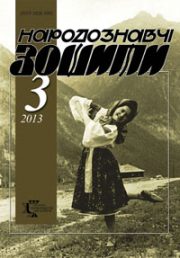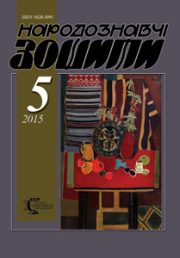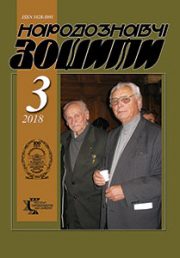The Ethnology Notebooks. 2023. № 3 (171), 549—566
UDK [39:[728.6:644.1]](477.86/.87+477.83)
DOI https://doi.org/10.15407/nz2023.03.549
RADOVYCH Roman
- ORCID ID: http://orcid.org/0000-0002-1900-8948
- Doctor of Sciences in History, Senior Researcher
- of the Institute of Ethnology
- of the National Academy of Sciences of Ukraine,
- in the Department of Historical Ethnology,
- 15, Svobody Avenue, 79000, Lviv, Ukraine,
- Contacts: e-mail: radovychroman@gmail.com
Abstract. Ethnologists primarily distinguish among a number of typological features horizontal planning and the heating system, studying traditional housing. Therefore, the study of the heating system, its individual components in general in Ukraine and in its individual ethnographic regions is extremely relevant. The heating system of a traditional home includes heating devices (open hearth, oven, stove, kitchen stove, etc.) and devices for smoke removal (chimneys-smoke collectors, «dymovoloky», chimneys-outputs, etc.). In the proposed investigation, the author sets himself the goal of finding out the peculiarities of the improvement of the heating system in the Boiko’s homes (the dynamics of the development of devices for removing smoke) and the processes of segmentation of the functions of the stove (the introduction of stoves, kitchen stoves, etc. into Boiko’s life).
The object of research is traditional construction, and the subject is the home heating system.
The methodological basis of the research is the principle of historicism in combination with elements of structural and functional analysis and the use of the main methods of ethnological science: retrospective, typological, complex and analysis, historical reconstruction, etc.
The territory of the study covers the entire territory of Boikivshchyna (including the «Priboikiv» (Boikos’) Pidhirria). Chronological boundaries of the study: 19th — the first half of the 20th century. The heating system on the territory of Boikivshchyna, in general, has never been a subject of special interest to scientists. Sources and literature of the end of the 19th and beginning of the 21st centuries contain separate, rather meager, information, so the author’s field materials collected in the villages of Boikivshchyna region during expeditions (1987—2020) serve as the source base of the work.
Keywords: heating system, smoke heating, semi-smoke heating, white heating, stove, kitchen stove.
Received 24.04.2023
REFERENCES
- Siletskyi, R. (2001). The problem of typology of heating devices of ancient dwellings in Ukraine (constructive and functional features of the furnace). Notes of NTSH (Pp. 230—247) [in Ukrainian].
- Makarchuk, S. (2012). Historical and ethnographic regions of Ukraine: teaching. manual [in Ukrainian].
- Hlushko, M. (2013). Pidhiria — a separate ethnographic unit of Ukraine? Bulletin of Lviv University: Historical series (Issue 48, pp. 299—318) [in Ukrainian].
- Zubrytskyi, M. (2013). Peasant houses in Mshanets, Starosambir district. In Zubrytskyi M. Collected works and materials in three volumes (Vol. I, pp. 477—493) [in Ukrainian].
- Zubrytskyi, M. (2013). The village of Kindrativ (Turka district) In Zubrytskyi M. Collected works and materials in three volumes (Vol. I, pp. 95—116) [in Ukrainian].
- Kobilnyk, V. (1936). Material culture of the village of Zhukotyna, Turchan district. Excerpt from «Chronicles of Boikivshchyna» (Part 7—9) [in Ukrainian].
- Kishchuk, T.P. (1983). Interior of a dwelling. Boikivshchyna: historical and ethnographic research [in Ukrainian].
- Danyliuk, A. (2004). Folk architecture of Boikivshchyna. Housing [in Ukrainian].
- Radovych, R. (2017). Polissya dweling: cultural and genetic origins and evolutionary processes. Lviv [in Ukrainian].
- Blomkvist, E.E. (1956). Peasant buildings of Russians, Ukrainians and Belorussians: (settlements, dwellings and economic structures) In East Slavic ethnographic collection: Essays on folk material culture of Russians, Ukrainians and Belarusians in the 19 — early 20 centuries (Pp. 3—458). Moscow: Publishing House of the Academy of Sciences of the USSR [in Russian].
- Siletskyi, R. (1999). The heating system of the folk dwelling of the polishchuky (types of heating devices, their design features, customs and beliefs). Polissia of Ukraine: materials of historical and ethnographic research (Vol. 2, pp. 125—140) [in Ukrainian].
- Vovk, Hv. (1995). Ethnographic features of the Ukrainian people. In Vovk, Hv. Studies on Ukrainian ethnography and anthropology (Pp. 39—218). Kiev: Art [in Ukrainian].
- Symonenko, I.F. (1956. Settlement, estate and housing in Transcarpathia. Materials for ethnography and artistic craft (Issue II, pp. 60—109) [in Ukrainian].
- Archive of National Academy of Sciences of Ukraine. F. 1. Op. 2, Ref. 279 [in Ukrainian].
- Mogytych, I.R. (1987). Housing. Folk architecture of the Ukrainian Carpathians of the 15th—20th centuries (Pp. 69—82) [in Ukrainian].
- Rainfuss, R. (1972). Folk architecture of Lemkos. Carpathian collection (Pp. 46—56) [in Russian].
- Sopolyha, M. (2016). Folk architecture of Ukrainians in Slovakia [in Ukrainian].
- Kepa, E. (1971). Arrangement of the residential interior in the Lemkiv region in the XIXth and XXth centuries. Materials of the Museum of Folk Architecture in Sanok, 13, 21—32 [in Polish].
- 19 Franko, I. (1982). Ethnographic expedition to Boikivshchyna. Collection of works: in 50 vol. (Vol. 36, pp. 68—99 [in Ukrainian].
- Kishchuk, T.P. (1983). Interior of a dwelling. Boikivshchyna: historical and ethnographic research (Pp. 166—169) [in Ukrainian].
- Zhatkovych, Yu. (2007). Ethnographic essay of South-Russians [in Russian].
- Lubicz-Czerwinski, I. (1811). Okolica zadniestrska miedzy Stryjem i Lomnica. Czyli opis ziemi, dawnych klesk lub odmian tej okolicy [in Polish].
- Krypiakevych, I.P. (1950). A Subcarpathian village in the 15th century (based on archival materials of the Lviv branch of the State Historical Archive of the Ukrainian SSR). Bulletin of the Academy of Sciences of the Ukrainian SSR, 12, 42—49 [in Ukrainian].
- Czajkowski, J. (1969). Wiejskie budownictwo mieszkalne w Beskidze Niskim i na przyleglym Pogorzu. Rocznik muzeow wojewodztwa Rzeszowskiego (Vol. ІІ)[in Polish].
- Franko, I. (1985). My paternal house. In Franko, I. Collected works: in 50 vol. (Vol. 39, pp. 243—244) [in Ukrainian].
- Holovatskyi, Ya. (1993). Journey through Galician and Hungarian Rus, described in letters to a friend in L. Journey to the Ukrainian Carpathians (Pp. 22—101) [in Ukrainian].
- Radovych, R. (1995). Traditional rural housing of Pidhiria at the end of the 19th — beginning of the 20th centuries. The Ethnology Notebooks, 4, 221—225 [in Ukrainian].
- Strzetelska-Grynbergowa, Z. (1899). Staromiejskie: ziemia i ludnosc [in Polish].
- Archive of the Museum of Folk Architecture and Life in Lviv (hereinafter — Archive NMFALL). F. Materials of expeditions. Ref. ЗВ-57 [in Ukrainian].
- Reinfuss, R. (1966). From studies on the folk culture of the Lemko region on both sides of the Carpathians. Quarterly of the Institute of Art of the Polish Academy of Sciences, 1 [in Polish].
- Haiova, E. (2019). Peculiarities of the revival of the material culture of Velykyi Bereznyi district in the exhibition «Carpathians» of the National Museum of Folk Architecture and Life of Ukraine. Scientific collection of the Transcarpathian Museum of Folk Architecture and Life (Issue 6, pp. 147—165) [in Ukrainian].
- (2020). Ethnographic image of modern Ukraine. Corpus of expeditionary folklore and ethnographic materials (Vol. 9: People’s housing culture. Ecology and organization of habitat) [in Ukrainian].
- Kotsan, V. (2018). Memories and information from the Verkhovyna village of Bukovets, Volovets district, Zakarpattia region: a manuscript written and edited in 1960—1968 by M.I. Parlag. Scientific collection of the Transcarpathian Museum of Folk Architecture and Life (Vol. 5, pp. 237—277) [in Ukrainian].
- Falkowski, J. (1937). The western borderland of the Hutsul region: the valleys of Prut, Bystrytsia Nadwornianska, Bystrytsia Soljtwinska and Lomnytsia [in Polish].
- Falkowski, J., & Pasznycki, B. (1935). On the Lemkiv-Boykiv border [in Polish].
- Falkovski, Ya. (1935). Village of Volosate, Lisky district. Chronicle of Boykivshchyna (Part 4—5). Sambir [in Ukrainian].
- Reinfus, R. (2020). Materials for studying the material culture of the Boikos [in Ukrainian].
- Hoshko, Y.G. (1976). The population of the Ukrainian Carpathians of the 15th—18th centuries. Settlement. Migration Everyday life. Kiev: Naukova dumka [in Ukrainian].
- Syvak, V. (2020). Interior of folk housing. Ethnographic groups of Ukrainians of the Carpathians. Boikos (Pp. 309—332) [in Ukrainian].
- Radovych, R. (2015). National architecture Staryi Sambir district in the nineteenth — first half of the twentienth century (housing and economic complex) [in Ukrainian].
- Liske, X. (1876). Cudzoziemcy w Polsce (L. Naker, U. Werdum, J. Bernoulli, J.E. Biester, J.J. Kausch) [in Polish].
- Moszynski, K. (1929). Folk culture of the Slavs (Vol. 1: Material culture) [in Polish].
- Pasternak, Ya. (1938). Fables for fifty years. Life and knowledge, 2, 49—51 [in Ukrainian].
- Lokotko, A.I. (1991). Belarusian folk architecture: middle of the 19th—20th centuries [in Russian].
- 45 Opolovnikov, A.V. (1983). Russian wooden architecture: Civil architecture [in Russian].
- Moszynski, K. (1928). Eastern Polessia. Ethnographic materials from the eastern part of the former Mazyr county and the Rzeczyki county [in Polish].
- Sivak, V. (2020). The cod lamp as a phenomenon in the folk dwellings of the Ukrainians of the Carpathians. Scientific collection of the Transcarpathian Museum of Folk Architecture and Life. (Issue 7, pp. 266—279) [in Ukrainian].
- Kozminova, A. (1922). Podkarpatska Rus. Praca a zivot lidu (Pp. 44—45) [in Czech].
- Tyvodar, M. (2011). Ethnography of Transcarpathia [in Ukrainian].
- Shukhevych, V. (1997). Hutsulshchyna (Part 1—2) [in Ukrainian].
- Fedaka, P.M. (2005). National housing of Ukrainians in Transcarpathia in the 18th and 20th centuries [in Ukrainian].
- Potushniak, F. (2010). Transcarpathian Ukrainian ethnography: significance, historiography, tasks, problems and their solutions, elements and their placement. In Tivodar M.P. Life and scientific researches of Fyodor Potushnyak (Pp. 153—254) [in Ukrainian].
- Archive NMFALL. F. Materials of expeditions. Ref. ЗВ-17 [in Ukrainian].
- Siletskyi, R. (2011). Traditional building rituals of Ukrainians [in Ukrainian].
- Radovych, R. (2013). An open hearth in the heating system of a stationary dwelling of Polissia. Bulletin of Lviv University. The series is historical (Issue 48, pp. 383—409) [in Ukrainian].
- Siletskyi, R. (2008). Heating devices of folk dwellings of Middle Polissia (constructive-functional and worldview aspects). Bulletin of Lviv University. The series is historical (Issue 43, pp. 134—183) [in Ukrainian].
- Marczakowa, K. (1967). The traditional dwellings and the most primitive fire devices in the province of Lublin. Studies and Lublin Materials (ethnography) (Vol. 2, pp. 172—175) [in Polish].
- Staszczak, Z. (1963). Peasant construction in the province of Lublin (in the ХІХ and ХХ centuries) (Vol. XXIV) [in Polish].
- Archive NMFALL. F. Materials of expeditions. Ref. ЗВ-39 [in Ukrainian].
- Radovych, R. (1999). Peculiarities of the dwelling heating system in the northwestern part of Halychyna and southwestern Volyn (second half of the 19th — early 20th centuries). The Ethnology Notebooks, 2, 224—231 [in Ukrainian].
- Samoilovych, V.P. (1977). People’s architectural creativity (based on the materials of the Ukrainian SSR) [in Ukrainian].







